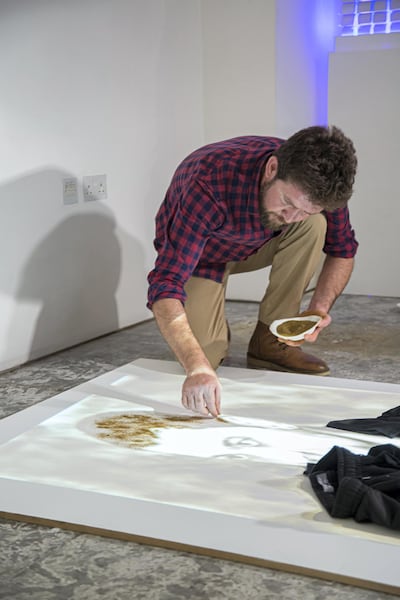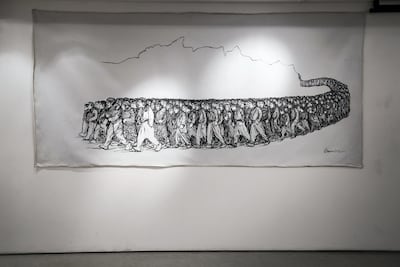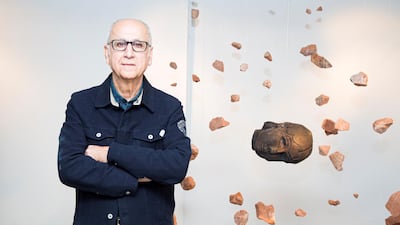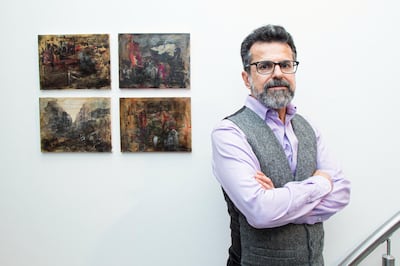Tucked away off the side of the busy Euston Road in London, around the corner from a makeshift mosque and a store selling Arabic books, is the P21 Gallery, devoted to Arab culture. A shop in the entrance sells Palestinian trinkets – embroidered bookmarks, weathered house keys – and the cafe offers maamoul cookies and dates.
This month, P21 is hosting the exhibition Road Through Kurdistan, put together by Gulan, a charity set up 10 years ago to promote Kurdish culture. The show, a focused look at art production in the Kurdish region, honours the 100-year anniversary of the post-First World War peace treaties in which the Kurdish people were denied a separate state. "It's the first of a kind in England to focus on Kurdish artists," says Mariwan Jalal, who co-curated the exhibition with British artist Richard Wilding, who is also creative director of Gulan. "It brings together artists of the young and old generation of Kurds."
Some of the artworks have come to London from Kurdistan, but most are from the diaspora in which many Kurdish artists live: Canada, Australia, the Netherlands, Italy, Denmark. The show also features artworks by Wilding and British artist Piers Secunda, who has spent time in the region. War and destruction are common themes, alongside celebrations of Kurdish life. Many of the artworks mix the two: Niaz Bayati, a Kurdish artist and designer who now resides in Denmark, made clay pots with intricately rendered bronze sculptures sitting atop the lids. One shows a group of rock partridges, small, sparrow-like birds that live in the mountaintops of Kurdistan. When the Peshmerga were pushed higher up the mountains, in a retreat from Saddam Hussein's forces, they drew inspiration from these songbirds, which were also eking out an existence in the forbidding terrain.
Wilding's photographs show contemporary life in Kurdistan, with images of children in international football jerseys standing side by side. Even these bright faces speak of conflict, internal to the camps. One of Gulan's trustees explains to me that school is the only time when the children from the different ethnic groups, who are housed in segregated areas in the camp, come together.
Kurdish artist Jalal also contributes paintings and ceramics to the exhibition, such as a thick snake that swerves in solid curves down the side of the wall. At each bend Jalal has tied a brightly coloured silk scarf, in reference to the Yazidi practice of tying knots in scarves on the tombs inside temples, which are guarded by thick sculptures of snakes like the one Jalal has made. You make a wish when you tie the knot, and when the next person comes to make their wish, they untie your knot – and your wish comes true.
While his piece borrows from tradition, Jalal believes that a general difference between the older and younger generation of Kurdish artists can be felt in their relationship to art itself. The younger generation is more in tune with wider trends in contemporary art, questioning how images travel or are reproduced, and participates more on the contemporary art circuit. Though these differences in approach were visible throughout the exhibition, tropes of memorialisation and loss appeared as constant themes from all the artists, regardless of age.

Ali Raza Garmiany, for example, who was born in Kurdistan in 1980 and now lives in Dublin, made a performance during the exhibition's opening that celebrates an extraordinary story from the time of Saddam.
For his artwork, Memory and Loss (2019), Garmiany projects an image of the face of a man on to the floor, and then traces his features with sand, using dark swathes of fabric to make up the body. "This work is taken from a larger project of 16 videos, each one based on the image of a survivor of the Anfal genocide of 1988," Garmiany explains. "A man named Taimoor was buried alive in the desert. He survived in the mass graves. It was a miracle. All of his family was killed right next to him. He was injured, but he survived. He was the only one to survive from the entire operation."
Here, Taimoor lies amid sand as a ghostly presence: a spectral, mustachioed man that Garmiany tended to, solicitously, during the crowded opening.

The work makes a nice counterpoint to an installation by Baldin Ahmed, an established artist from the older generation, in which the serene face of an ancient sculpture hangs suspended among strewn rocks, some of which have crashed to the ground. The figure, hanging on its side as if mid-explosion, is a replica of the famous Mask of Warka, a Sumerian sculpture from 3100 BC. Thought to depict a Sumerian queen or the goddess Inanna, with large almond-shaped eyes and arching eyebrows, the Mask of Warka is said to be the first naturalist depiction of the human face. It was housed in the National Museum of Iraq and looted after the US occupation of Baghdad. American forces later recovered it after a tip came in: it had been buried at a farm in northern Iraq, and has since been returned to the museum. The loss and return of the Mask have only added to its potential as an evocative subject.
"I have been thinking of this sculpture for 10 years," Ahmed says about the work, titled The Age of the World (2019). "Beauty and memory will always win over destruction."
Jalal echoes this sentiment, adding that a motivation for the exhibition was to broadcast another story of Kurdish life: "We want to promote Kurdish artists, not just stories of tragedy; of the Anfal."
Statements like these often surround exhibitions of art from war-torn countries, but – perhaps against its own desires – Road Through Kurdistan itself told a different story. The opposition of war and culture, and tragedy and art really only functions rhetorically. As the Kurdish artists assembled for this exhibition show, the experience of violence is now built into contemporary Kurdish life, and destruction is inseparable from its memories.
Road Through Kurdistan is on show at P21 Gallery in London until Saturday, October 26



